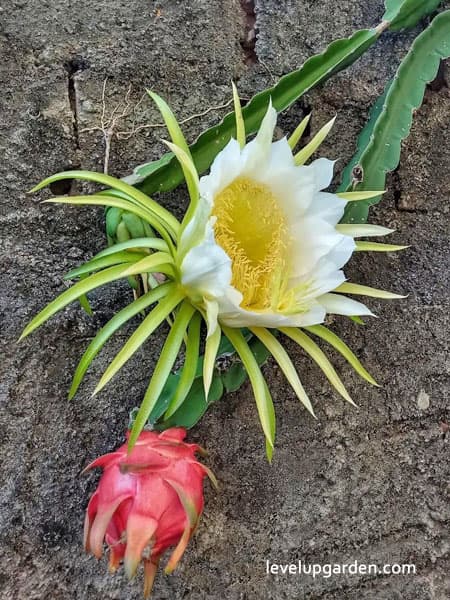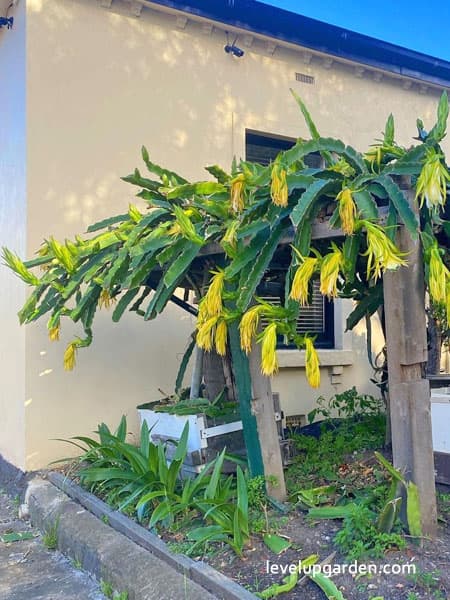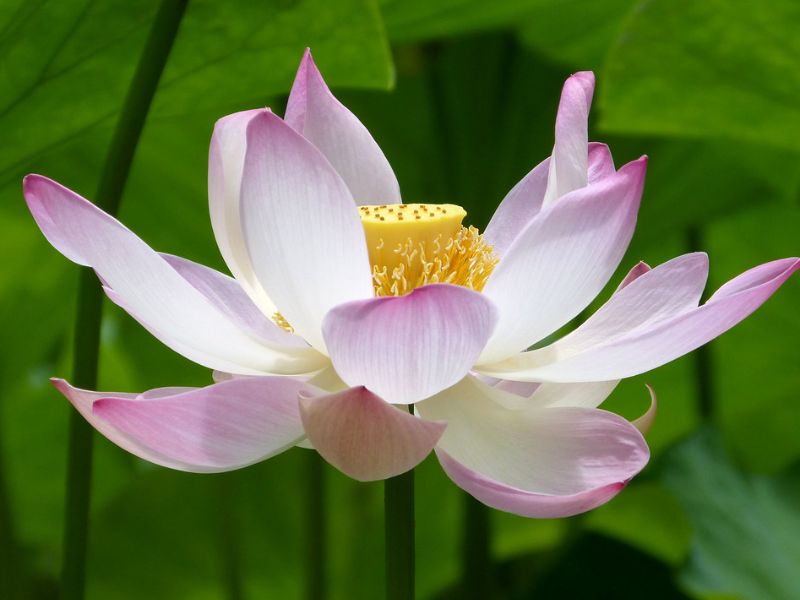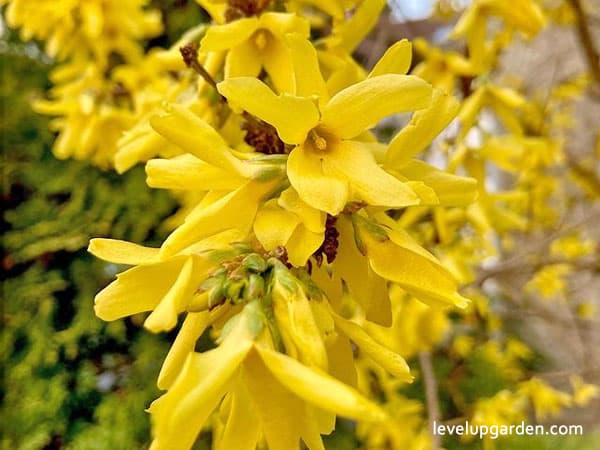Dragon Fruit (Selenicereus undatus) is known as Belle-Of-The-Night, Cinderella Plant, Dragon Fruit Tree, Honolulu Queen, Jesus in the Cradle, Moonflower, Moonlight Cactus, Nightblooming Cactus, Night Blooming Cereus, Pitahya Plant, Pitaya, Queen of the Nigh, tRed Pitaya, Strawberry-Pear, is an otherworldly fruit, native to Mexico, Central America, and South America, it is one of several fruits made from cacti. Read on to learn everything about this plant before you grow it in your garden.

Dragon fruit, used as an ornamental vine and as a fruit tree, is a fast-growing, vine-like, terrestrial, or epiphytic cactus. The green stem is usually triangular, fleshy, and jointed, and may reach 20 feet (6 m) in length. It climbs by aerial roots that attach it to the ground surface. In temperate regions, it produces large, beautiful white flowers, 35 cm long, from late spring to early summer. It flowers and bears 4-6 times a year in tropical regions. Very fragrant, it flowers at night and usually lasts only one night. When pollinated, it produces thick-fleshed red fruits with prominent scales, which are edible. The sweet-smelling white or red flesh is dotted with small black seeds. The life span of the dragon fruit is about 20 years, and 3-4 years after planting, it is said to produce as much as 220 pounds (100 kg) of fruit per year.
I. Dragon Fruit (Selenicereus undatus) Profile – An Overview of the plant

| Common names | Dragon Fruit, Belle-Of-The-Night, Cinderella Plant, Dragon Fruit Tree, Honolulu Queen, Jesus in the Cradle, Moonflower, Moonlight Cactus, Nightblooming Cactus, Night Blooming Cereus, Pitahya Plant, Pitaya, Queen of the Nigh, tRed Pitaya, Strawberry-Pear. |
| Botanical Name | Selenicereus Undatuss. Previously known as Hylocereus undatus |
| Native Area | Mexico, Central America, South America |
| Plant Type | Cactus – Succulents, Fruit |
| Exposure | Full Sun, Partial Sun |
| Soil Drainage | Well-Drained |
| Sun Exposure | Full sun, partial shade |
| Soil Type | Sandy, well-drained |
| Soil pH | Neutral to acidic |
| Bloom Time | Spring, summer, fall, winter |
| Flower Color | White |
| Hardiness Zones | 10 – 12 (USDA) |
| Mature Size | 10 – 20 ft. tall, 5 – 10 ft. wide |
| Water Needs | Average |
| Maintenance | Average |
| Growth Rate | Fast |
| Harvest Time | May – July |
II. Dragon Fruit (Selenicereus undatus) Appearance

- Leaf: Greenish-yellow to white leaves with tapered ends.
- Stem: Stems reach up to 5 inches thick, with nodes from 12 to 48 inches apart in various locations. Nodes have small needle-like spines.
- Flower color: Rosette-shaped flowers open at night and close during the day. They have white petals and yellow stamens, with a conspicuous flower column.
III. Dragon Fruit Growing and Care Conditions

It is the most widely grown species in the genus. It is harvested as a commercial crop in many countries, and farmers can expect five to six harvests each year. Fruit weights range from 1/2 pound up to 3 pounds. The fruit is also used to color juice and some alcoholic beverages. The flowers as well as the fruit are edible. They are used to brew tea.
- Water: Dragon fruit cactus should be treated as a tropical cactus and watered when almost dry. An automatic dripper at the top of the support pole works well. The most common cause of premature death of cacti is overwatering. Many ornamental containers do not have drainage holes in the bottom. Regular watering will cause the roots at the bottom of the pot to become waterlogged and root rot will begin. Keep this in mind when purchasing cactus pots.
- Light: Dragon fruit prefers warm climates and is often planted in sunny locations, but too much strong sunlight in dry or especially hot areas can damage the stems. If temperatures in your area are often near 100 degrees Fahrenheit, it is best to plant the cactus in partial shade. Also, note that placing it in too much shade will result in poor fruit production and a poor-quality harvest.
- Fertilizer: Fertilizer is toxic to dragon fruit cacti, and too much can kill the plant. The best fertilizer is a low nitrogen cactus fertilizer applied sparingly and slowly over time. For in-ground plants, apply a balanced granular fertilizer once a month. Dragon fruit cactus is a light feeder, but if left unfertilized, it tends to grow very slowly and become virtually dormant. To maintain a rich, full appearance, apply fertilizer every two months, but be careful not to overfeed.
- Soil: Dragon fruit cacti are not very particular about soil type or pH level. What is important is that the soil is moist, rich in organic matter, and well-drained. Mulching the base of the plant is also recommended to keep the soil moist, especially in drier areas.
- Temperature and Humidity: Dragon fruit plants are not suitable for all gardens. Since they are native to tropical regions, they do not do well in areas that freeze, especially if that freeze is long-lasting. Temperatures between 65 and 80 degrees Fahrenheit are considered optimal for dragon fruit growth.
- Planting: A sunny location is best. If planting outdoors, assume that the plant will be allowed to go dormant until it becomes acclimated to its new environment. Dragon Fruit Cactus prefers bright light and should be kept out of the shade as much as possible. They also prefer well-drained soil. Sandy cactus culture medium (if grown in containers) works well. Avoid moist or muddy soil. In temperate regions, dragon fruit can be potted and brought indoors.
- Pests and Diseases: In some areas, wildlife may find dragon fruit attractive depending on where you live. You may need to take measures to protect the cactus and its fruit from rats, raccoons, and birds. It is also an attractive plant for ants, mites, ticks, and slugs.
- Cankers and rotting of stems and fruit may also be a problem for dragon fruit cacti. Be sure to provide your cactus with the proper amount of sun, moisture, and air circulation to avoid these problems.
V. Uses
Perhaps even more interesting than the appearance of dragon fruit is its taste. When the pink outer skin is peeled off, the milky white flesh is covered with small black seeds similar to kiwi, adding a crunchy texture to the juicy pulp. It has a sweet and slightly sour taste, like a cross between a melon and a pear, and is delicious when eaten cold.

You can use dragon fruit to make homemade sorbets, smoothies, and tropical drinks to quench your summer thirst. It is also delicious when used in jellies, jams, and sauces. Not only does dragon fruit have many uses in the kitchen, but it is also considered one of the healthiest fruits on the planet.
VI. Why should you buy a Dragon Fruit plant?
Dragon fruit trees bring beauty and curiosity to your garden and landscape. This wonderful fruit tree of the cactus family is full of wonderful surprises. First, this tree has a uniquely exotic charm. Its trunk looks like a palm tree, intertwined with cactus-like vines. This Southeast Asian style tree would make a great specimen tree for an oriental garden or tropical motif.
The large white flowers are nearly a foot long and add a splash of color. These lovely flowers are not only beautiful but also fragrant. But the real attraction is the dragon fruit itself. Everything about this fruit is wonderfully different. From its oval shape to its striking neon pink color, the dragon fruit stands out in the landscape. No other fruit is as attractive.
VI. FAQs
How long does it take to grow a Dragon Fruit tree?
Dragon Fruit tree flowers in as little as 6-8 months but can take up to two years to bear fruit when grown in containers. However, the good news is that once mature, fruiting can occur four to six times a year from a plant that can produce fruit for 20 to 30 years.
Can I grow Dragon Fruit in my area?
It is possible that in USDA zones 9-11, Dragon Fruit can probably survive outdoors all year round. However, if you live outside of warmer climates, this plant is a good candidate for containers, and you can move the plant and pot indoors when the colder months arrive.
Is Dragon Fruit easy to grow?
Dragon Fruit can be easily grown from seeds or cuttings. To grow from seed, crush the pulp on paper towels and keep moist in a warm place out of direct sunlight. Seeds will germinate in two to three weeks and can be potted.







